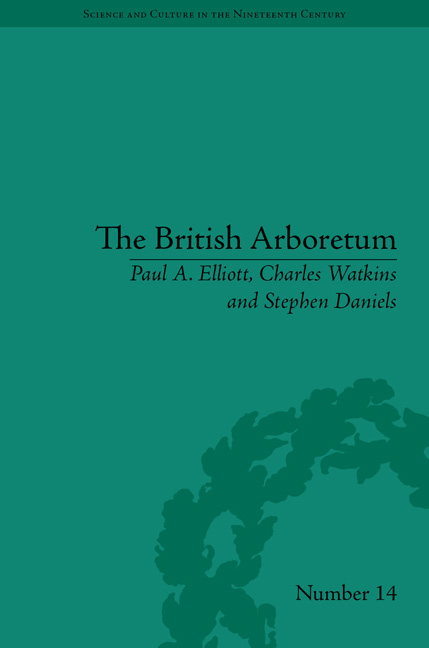Book contents
- Frontmatter
- CONTENTS
- List of Figures
- Preface
- Introduction
- 1 British Tree Cultures in the Nineteenth Century
- 2 Trees and Taxonomy
- 3 British Arboriculture, c. 1800–35
- 4 John Claudius Loudon's Arboretums
- 5 The Botany of the Arboretum Britannicum
- 6 The Derby Arboretum
- 7 Estate Arboretums
- 8 Public Urban Arboretums
- 9 The Transformation of Victorian Public Arboretums
- Conclusion
- Notes
- Works Cited
- Index
Conclusion
- Frontmatter
- CONTENTS
- List of Figures
- Preface
- Introduction
- 1 British Tree Cultures in the Nineteenth Century
- 2 Trees and Taxonomy
- 3 British Arboriculture, c. 1800–35
- 4 John Claudius Loudon's Arboretums
- 5 The Botany of the Arboretum Britannicum
- 6 The Derby Arboretum
- 7 Estate Arboretums
- 8 Public Urban Arboretums
- 9 The Transformation of Victorian Public Arboretums
- Conclusion
- Notes
- Works Cited
- Index
Summary
He faced, across half an acre of lawn, what the previous owners had called their ‘arboretum’. Ludovic thought of it merely as ‘the trees’. Some were deciduous and had now been stripped bare by the east wind that blew from the sea, leaving the holm oaks, yews, and conifers in carefully contrived patterns, glaucous, golden and of a green so deep as to be almost black at that sunless noon.
Evelyn Waugh, Unconditional SurrenderBy the mid-twentieth century the term arboretum was relatively commonplace. It referred to a place where collections of trees were grown and displayed systematically, sometimes planted according to botanical taxonomies, labelled and catalogued. For some, such as Evelyn Waugh, arboretums had become hackneyed; the quotation above describes an arboretum in the garden of a ‘large, requisitioned villa in a still desolate area of Essex’, in 1943. Here the term is consciously pompous and affected, describing the remnant of a small tree collection in the garden of a modest house; but as we have seen, in the nineteenth century arboretums were perceived as innovative and exciting places.
This study has explored the development of arboretums in the period, arguing that there was a close relationship between botany and arboriculture and that the latter encouraged the adoption of the natural system in Britain. It has examined the emergence of tree collections intended to provide botanical education including botanical gardens, private estates and public sites where collections were displayed.
- Type
- Chapter
- Information
- The British ArboretumTrees, Science and Culture in the Nineteenth Century, pp. 229 - 234Publisher: Pickering & ChattoFirst published in: 2014



